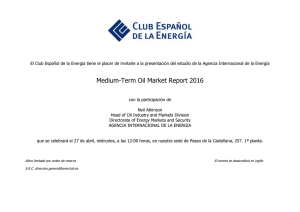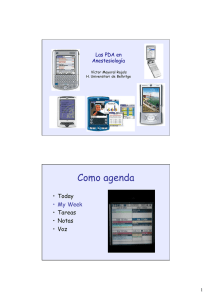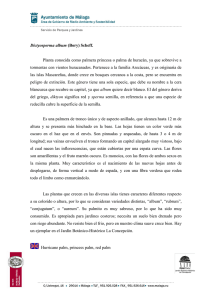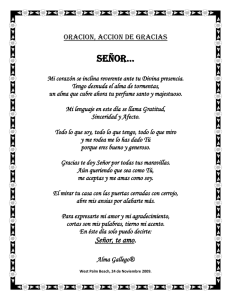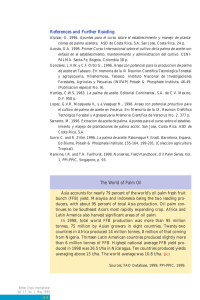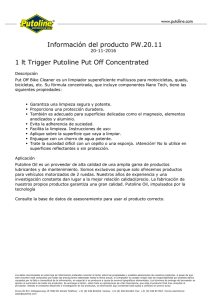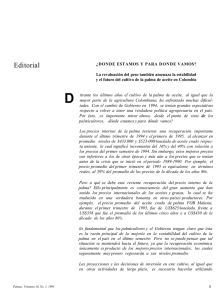mencionan la posibilidad de explotar en forma se
Anuncio
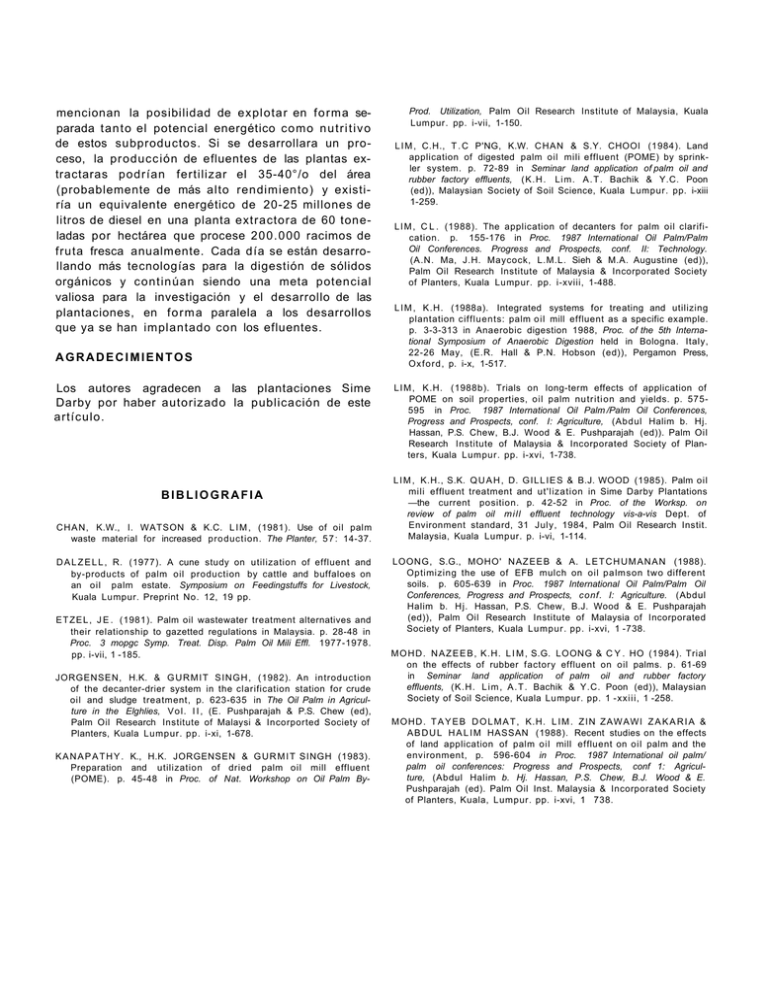
mencionan la posibilidad de explotar en forma separada tanto el potencial energético como n u t r i t i v o de estos subproductos. Si se desarrollara un proceso, la producción de efluentes de las plantas extractaras podrían fertilizar el 35-40°/o del área (probablemente de más alto rendimiento) y existiría un equivalente energético de 20-25 millones de litros de diesel en una planta extractora de 60 toneladas por hectárea que procese 200.000 racimos de fruta fresca anualmente. Cada día se están desarrollando más tecnologías para la digestión de sólidos orgánicos y continúan siendo una meta potencial valiosa para la investigación y el desarrollo de las plantaciones, en f o r m a paralela a los desarrollos que ya se han implantado con los efluentes. AGRADECIMIENTOS Los autores agradecen a las plantaciones Sime Darby por haber autorizado la publicación de este artículo. BIBLIOGRAFIA C H A N , K.W., I. WATSON & K.C. L I M , (1981). Use of oil palm waste material for increased production. The Planter, 5 7 : 14-37. D A L Z E L L , R. (1977). A cune study on utilization of effluent and by-products of palm oil production by cattle and buffaloes on an oil palm estate. Symposium on Feedingstuffs for Livestock, Kuala Lumpur. Preprint No. 12, 19 pp. E T Z E L , J E . (1981). Palm oil wastewater treatment alternatives and their relationship to gazetted regulations in Malaysia. p. 28-48 in Proc. 3 mopgc Symp. Treat. Disp. Palm Oil Mili Effl. 1977-1978. pp. i-vii, 1 -185. JORGENSEN, H.K. & G U R M I T SINGH, (1982). An introduction of the decanter-drier system in the clarification station for crude oil and sludge treatment, p. 623-635 in The Oil Palm in Agriculture in the Elghlies, V o l . I I , (E. Pushparajah & P.S. Chew (ed), Palm Oil Research Institute of Malaysi & Incorported Society of Planters, Kuala Lumpur. pp. i-xi, 1-678. K A N A P A T H Y . K., H.K. JORGENSEN & G U R M I T SINGH (1983). Preparation and utilization of dried palm oil mill effluent (POME). p. 45-48 in Proc. of Nat. Workshop on Oil Palm By- Prod. Utilization, Palm Oil Research Institute of Malaysia, Kuala Lumpur. pp. i-vii, 1-150. L I M , C.H., T . C P'NG, K.W. CHAN & S.Y. CHOOI (1984). Land application of digested palm oil mili effluent (POME) by sprinkler system. p. 72-89 in Seminar land application of palm oil and rubber factory effluents, ( K . H . Lim. A . T . Bachik & Y.C. Poon (ed)), Malaysian Society of Soil Science, Kuala Lumpur. pp. i-xiii 1-259. L I M , C L . (1988). The application of decanters for palm oil clarification. p. 155-176 in Proc. 1987 International Oil Palm/Palm Oil Conferences. Progress and Prospects, conf. II: Technology. (A.N. Ma, J.H. Maycock, L.M.L. Sieh & M.A. Augustine (ed)), Palm Oil Research Institute of Malaysia & Incorporated Society of Planters, Kuala Lumpur. pp. i-xviii, 1-488. L I M , K.H. (1988a). Integrated systems for treating and utilizing plantation ciffluents: palm o i l mill effluent as a specific example. p. 3-3-313 in Anaerobic digestion 1988, Proc. of the 5th International Symposium of Anaerobic Digestion held in Bologna. Italy, 22-26 May, (E.R. Hall & P.N. Hobson (ed)), Pergamon Press, O x f o r d , p. i-x, 1-517. L I M , K.H. (1988b). Trials on long-term effects of application of POME on soil properties, oil palm nutrition and yields. p. 575595 in Proc. 1987 International Oil Palm /Palm Oil Conferences, Progress and Prospects, conf. I: Agriculture, (Abdul Halim b. Hj. Hassan, P.S. Chew, B.J. Wood & E. Pushparajah (ed)). Palm Oil Research Institute of Malaysia & Incorporated Society of Planters, Kuala Lumpur. pp. i-xvi, 1-738. L I M , K.H., S.K. Q U A H , D. G I L L I E S & B.J. WOOD (1985). Palm oil mili effluent treatment and ut'lization in Sime Darby Plantations —the current position. p. 42-52 in Proc. of the Worksp. on review of palm oil mill effluent technology vis-a-vis Dept. of Environment standard, 31 July, 1984, Palm Oil Research Instit. Malaysia, Kuala Lumpur. p. i-vi, 1-114. LOONG, S.G., MOHO' N A Z E E B & A. L E T C H U M A N A N (1988). Optimizing the use of EFB mulch on oil palmson two different soils. p. 605-639 in Proc. 1987 International Oil Palm/Palm Oil Conferences, Progress and Prospects, conf. I: Agriculture. (Abdul Halim b. Hj. Hassan, P.S. Chew, B.J. Wood & E. Pushparajah (ed)), Palm Oil Research Institute of Malaysia of Incorporated Society of Planters, Kuala Lumpur. pp. i-xvi, 1 -738. M O H D . N A Z E E B , K.H. L I M , S.G. LOONG & C Y . HO (1984). Trial on the effects of rubber factory effluent on oil palms. p. 61-69 in Seminar land application of palm oil and rubber factory effluents, (K.H. L i m , A . T . Bachik & Y.C. Poon (ed)), Malaysian Society of Soil Science, Kuala Lumpur. pp. 1 -xxiii, 1 -258. M O H D . T A Y E B D O L M A T , K.H. L I M . Z I N Z A W A W I Z A K A R I A & A B D U L H A L I M HASSAN (1988). Recent studies on the effects of land application of palm oil mill effluent on oil palm and the environment, p. 596-604 in Proc. 1987 International oil palm/ palm oil conferences: Progress and Prospects, conf 1: Agriculture, (Abdul Halim b. Hj. Hassan, P.S. Chew, B.J. Wood & E. Pushparajah (ed). Palm Oil Inst. Malaysia & Incorporated Society of Planters, Kuala, Lumpur. pp. i-xvi, 1 738.
